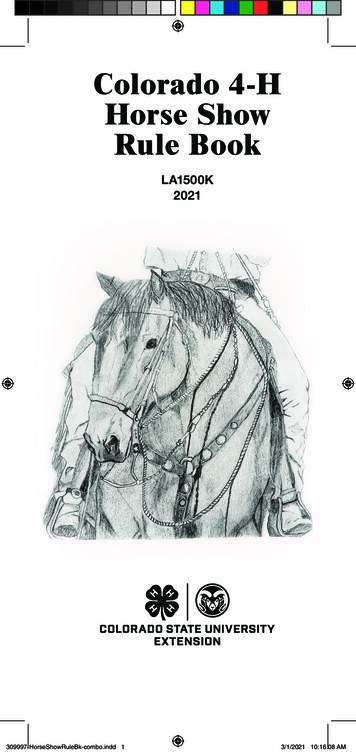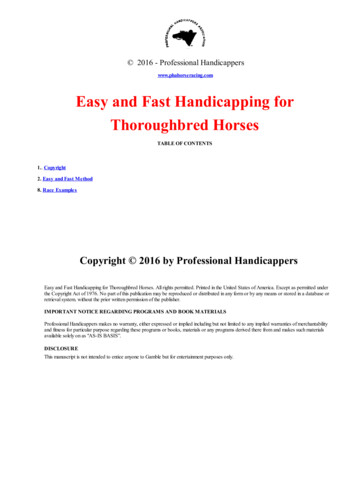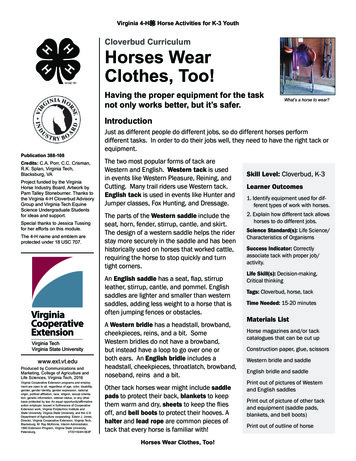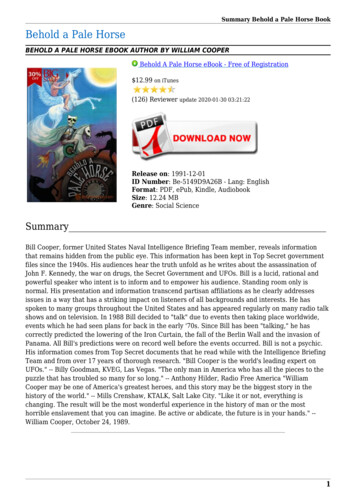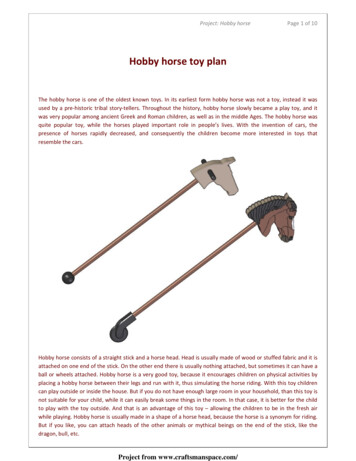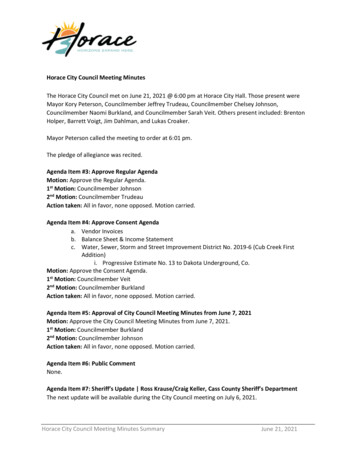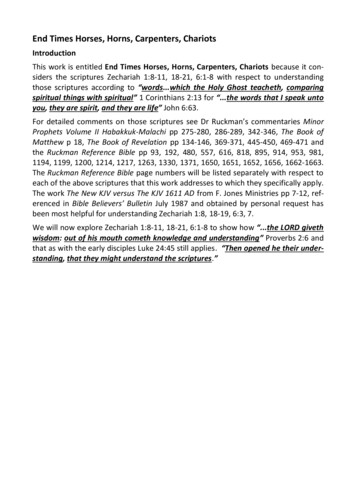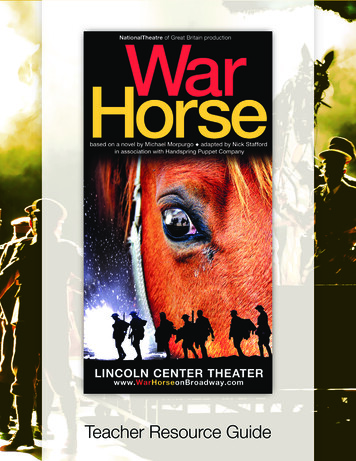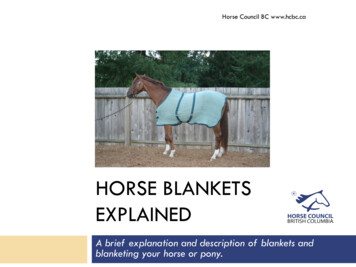
Transcription
Horse Council BC www.hcbc.caHorse Council BC’sClick and Learn SeriesHORSE BLANKETSEXPLAINEDA brief explanation and description of blankets andblanketing your horse or pony.
Types of Blankets Rain sheetsFly sheetsQuarter sheetsCoolersSummer sheetsStable blanketsBlanket linersDress sheetsTurnoutsThis list is not all inclusive, but some of the most commonly used blankets.Horse Council BC www.hcbc.ca
To Blanket or not to Blanket(an individual choice)RaiHorsesare blanketed for many reasons. Theyinclude: Keeping the horse dryKeeping the clipped horse warmKeeping the horse cleanReducing grooming timeAllowing the horse to work in the winter and dry faster by keepinghis winter coat lighter.Keeping the hair growth of an unclipped horse to a minimumThe horses is elderly or sick and required more help to keep warm.To reduce bleaching of the coat during summer months.To keep the horses coat appearance “show ready”Horse Council BC www.hcbc.ca
To Blanket or not to Blanket(an individual choice)Horses are not blanketed for many reasons.They include: The horse lives a natural life outdoors and has plenty of shelteragainst the elementsThe horse has a long thick winter coat and does not require extraheating or protectionThe horse is not being ridden or workedThe horse is turned out in a group which enjoys ripping each othersblankets off.The horse has a long, thick, warm winter hair coat and is not riddenhardThe weather is mild.This list is not all inclusive, but some of the most commonly used blankets.Horse Council BC www.hcbc.ca
Important features Durability Horse blankets must be extremely hardy and durable towithstand energetic outdoor play, some chewing and tugging as well as allaround wear and tear. No blanket is 100% wear and tear proof butdiligent care and attention should extend the life of your blankets. Strapsand buckles can be replaced as required. Some horses are extremely“hard” on blankets while others will wear them and leave them alone.Fabric Outdoor turnout blankets for horses must be both waterproof andbreathable. The material of the blanket is based on what the blanket isdesigned to be used for. There are many different types of blanketmaterials, each with a different reason and use ranging from rip stopcanvas to light cotton. Turnout blankets should be waterproof, stableblankets do not need to be.Horse Council BC www.hcbc.ca
Important Features Fit A proper fitting horse blanket may protect an equine from the elements,while also providing comfort and warmth. Well-constructed horse blanketsmay feature chest buckles, hook-and-loop front closures or both. Horseblanket shoppers also look for tailored shoulder gussets, adjustable bellystraps, tail strings and detachable leg straps. The horse must be able tomove comfortably and naturally wearing a blanket. Make sure youmeasure your horse correctly and talk to the tack store staff regarding yourhorse, they will be able to assist you with a choice. Your coach may also beable to help you fit your horse. Neck styles vary from a regular neck, ahigh or comfort neck or a complete neck that resembles a hood.Horse Council BC www.hcbc.ca
Important Features Price Horse blanket prices may vary considerably. Heavy winter horseblankets for turnout may range from approximately 50 to more than 400. Often it is possible to purchase used blankets for a reasonableprice.Appearance When purchasing a new or used blanket, buyers may selectcertain colors and styles of horse blankets to suit their horse’s color, theirbarn colors or just a personal favorite color. Color should never be thedeciding factor when choosing the right blanket! Blankets can also beequipped with tail flaps, gussets or hoods to add extra usage andcoverage.Horse Council BC www.hcbc.ca
Waterproof or Not? If you have purchased a blanket that you intend to use when your horse is turnedout during seasons where there is rain and snow, the blanket should be waterproof.A cold, wet, soggy blanket does more harm than good.If the blanket is for use in the stable, as an blanket liner, stable sheet or cooler thenit does not need to be waterproof.Once washed, blankets may require an application of a water-proofing substanceto remain useful and waterproof. Always read the manufacturers directions whenwashing a blanket.No blanket will ever be 100% waterproof, be sure you check your horse often tomake sure they are still dry.Blankets that bulge open at the shoulder will often allow water to drip down insidethe blanket. Make sure that the blanket fits as well as possible.Periodic inspection of blankets for tears or leaks is recommended, be sure to“scotchguard” any repairs made before using.Horse Council BC www.hcbc.ca
Weights and FillsTurnout blankets come in a variety of weights, fills and materials.When purchasing a blanket make sure that you match theintended usage with the blanket that fits your horse’s needs.Winter blanket outer layers are measured in “denier”, essentiallythe higher the denier count the higher the thread weave andthe durability of the material.Blanket “fills” are the material in the blanket that adds warmth.Medium weight blankets have up to 200 grams of fill, whileheavy weight blankets will have up to 420 grams of fill.Horse Council BC www.hcbc.ca
How to measure Measure Your HorseFind a level spot and have an assistanthold your horse. Use a flexible clothmeasuring tape.Stand your horse squarely on all fourlegs and face him to the left.Hold the measuring tape at the centerof your horse’s chest (A) at the pointwhere neck and chest meet, andKeeping your tape level, measurearound the widest part of the shoulderand along the barrel and around thewidest part of the hindquarter - to theside of the tail (B).Your tape should remain tight and levelagainst all measuring points of thehorse. The blanket size for your horse is the resultingmeasurement from point A to Point B. If you measure74 inches from A to B, then your horse wears a Size 74.If your measurement is an odd number, use the nexthighest even number.Horse Council BC www.hcbc.ca
Rain SheetsRainsheet’s are used toprotect the horse from rainand weather and to keepthem dry. They can beunlined or lined. A linedRainsheet will also keepyour horse warmer. Whenused over a liner or nonwater proofed blanket, therain sheet give waterproofed protection to theliner.Unlined light weight sheet can beused alone or over a linerHorse Council BC www.hcbc.ca
Fly SheetsLight weight meshFly sheets areused to protectthe horse fromflies and bitinginsects.Horse Council BC www.hcbc.ca
Quarter SheetsQuarter sheetQuarter sheets areused for severalpurposes. Theykeep the loin areaof the horse warmwhile warming upor cooling downduring exercise.They also provideprotection from therain while riding.Some even have“keyhole” flapsthat can cover thehorses legs aswell. Quartersheets can bemade of fleece orwool or any othersimilar material.Horse Council BC www.hcbc.ca
CoolersFleece fitted coolerFull wool coolerCoolers are used the help cool outand dry a horse after work. They arealso used to provide warmth to thehorse while in its stall or beingwalked.Horse Council BC www.hcbc.ca
Summer SheetsLight weight, unlined sheetSummer sheets areused to help keepthe horse clean at acompetition orprovide very lightwarmth whenrequired. Summersheets can also beused as a stableblanket.Horse Council BC www.hcbc.ca
Stable Blankets and Blanket linersQuilted blanket linerStable BlanketThese blankets are used to providewarmth. The liner can be used alone toprovide warmth in the stall or under awaterproof rain sheet . A stable blanket isused to provide warmth while the horse isstabled or for turnout in dry weather.Horse Council BC www.hcbc.ca
Turnout BlanketsHigh neck turn outRegular neck turn outTurnout blankets provide warmth andprotection from rain to the horse whileoutside. They come in a variety of weightsand fills, and should be waterproof.Horse Council BC www.hcbc.ca
In closing . Blankets should be checked regularly for wear and tear and repaired asrequiredBlankets should be checked regularly for correct fitBlankets can be washed and dried, following the manufactures directions, orat a special horse blanket laundry facilityBlanket rubs are an indication that the blanket may not fit correctlyBlankets should be used for the purpose they were designed for or theymay be ineffective or cause harmWinter blankets can be hung to dry when required, in a warm dry place.Ideally you would have 2, one on the horse and one drying.Horse Council BC www.hcbc.ca
Horse Council BC “Click and Learn” seriesBlanket Basics Thank you to our model Brazil who was gracious enough to allow us to photograph him and his wardrobe.Check out the HCBC Online Bookstore http://store.hcbc.ca/catalog/ we carry hundreds of EquineRelated titles on many subjects including blanketing horses. Horse Council BC www.hcbc.ca 27336 Fraser Hwy, Aldergrove, Bc V4W 3N5 604-856-4304 1-800-345-8055 Fax 604-856-4302Horse Council BC www.hcbc.ca
A proper fitting horse blanket may protect an equine from the elements, while also providing comfort and warmth. Well -constructed horse blankets may feature chest buckles, hook- and-loop front closures or both. Horse blanket shoppers also look for tailored shoulder gussets, adjustable belly straps, tail strings and detachable leg straps.
